![]()
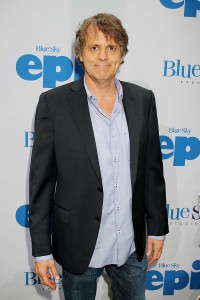
Wedge added that he wanted to “build a magical place with animation and honor some of the roots of what makes animation great.”
The film, which opened in May and is now on the shortlist for the best animated film Oscar, tells the story of an ongoing battle between the forces of good, who keep the natural world alive, and the forces of evil, known as the Boggans, who wish to destroy it. When a teenage girl (Amanda Seyfried) finds herself magically transported into this tiny world, she teams up with an elite band of warriors known as the Leafmen to save the world.
Wedge explained that by 2004, they had developed a first draft of the script and started doing elaborate animation tests in 2006, but it wasn’t until 2009 that he was able to get a greenlight.
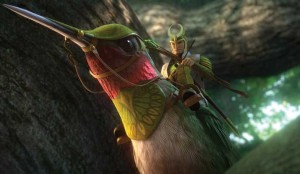
Wedge, who is one of the co-founders of Connecticut-based animation studio Blue Sky Studios, explained that Blue Sky has a little over 500 employees, and through the course of production, at one point or another, each one of them touched the movie in some way.
Wedge started by tapping long-time collaborator production designer Greg Couch to help develop the look of this tiny forest kingdom. “He’s been at Blue Sky since Ice Age,” said Wedge. “He’s one of my go-to collaborators. He’s incredibly talented and Michael Knapp was the art director. He contributed a tremendous amount in the execution of things.” Writer William Joyce also contributed to the production design.
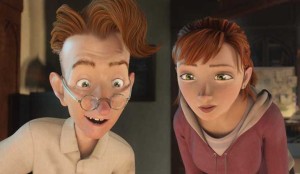 According to Wedge, the level of detail in Epic surpasses that of any other animated film Blue Sky has released. “As far as the technique goes, we just threw in a lot more detail than we’d ever done before. We set a very high bar right at the beginning, which we had to maintain.”
According to Wedge, the level of detail in Epic surpasses that of any other animated film Blue Sky has released. “As far as the technique goes, we just threw in a lot more detail than we’d ever done before. We set a very high bar right at the beginning, which we had to maintain.”
The film depicts the struggle between good and evil set in a lush forest environment where tiny Leafmen battle the Boggans to save the world, but these creatures are too small and too fast for normal-sized humans to even notice. The depth of detail and cinematic scope of the film are striking. Wedge explained that Renato Falcão heads Blue Sky’s camera department and is responsible for bringing a “cinematic eye” to the studio’s animated films. “Renato would sit in every time we were having a layout meeting, and when we were placing cameras, he was there by my side.”
“I kept saying to everybody at the beginning that I wanted to make an animated movie that looked and felt more like a live-action movie,” explained Wedge. “We wanted a little more natural cinematography, and went a little wider in aspect ratio than we have typically.”
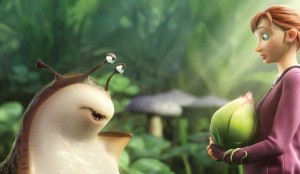 He was also trying to achieve more realistic human characters.
He was also trying to achieve more realistic human characters.
“The modelers had to deal with a lot more detail and realistic human proportions than we’ve ever tackled. As you get closer to human motion, the audience’s eye is a little more discerning,” said Wedge. “That was a huge challenge, trying to get characters that were less cartoony, while staying away from the edge of the ‘uncanny valley.’”
But that was also one of the most fun aspects of the project for the animators.
“The animators created a lot of their own acting references, so once we’ve cut the dialog together, the animators go in, and as they’re breaking down a scene and designing their animation, they videotape their own takes, shooting themselves and their friends just to create a reference for the action. Of course, all of the action in the film is keyframed and pretty far removed from the video that is recorded, but it gives them something to start with.”
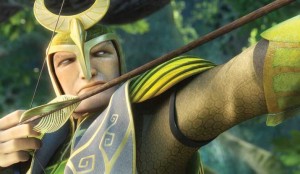 One of the film’s most spectacular scenes is when an old three-legged Pug named Ozzy chases the Leafmen, switching between the “real-time” perspective of the dog, and the slow-motion perspective of the tiny Leafmen. “As animators and filmmakers that was some of the most fun stuff to work on, because in those scenes, we go back and forth between all those perspectives – big and small, and fast and slow and try to get the most out of those perspectives,” said Wedge.
One of the film’s most spectacular scenes is when an old three-legged Pug named Ozzy chases the Leafmen, switching between the “real-time” perspective of the dog, and the slow-motion perspective of the tiny Leafmen. “As animators and filmmakers that was some of the most fun stuff to work on, because in those scenes, we go back and forth between all those perspectives – big and small, and fast and slow and try to get the most out of those perspectives,” said Wedge.
Achieving the level of detail in the trees, grass and other foliage in the film’s lush backgrounds was another key challenge that required a great deal of attention and care.
“We’ve created a lot of software over the years to do that kind of propagation and there’s some measure of automation that will help distribute trees over a hillside or leaves on a tree, and then blow them in the wind, but it’s still animation. It takes forever. It’s painstaking and complicated and a lot of it is done by hand,” said Wedge.
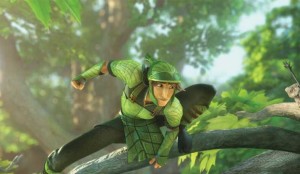 Wedge said that he is very “hands-on” when it comes to sound. “I believe wholeheartedly that 50 percent of the picture is the sound. It’s one of my favorite parts of the postproduction process. It was a great boon for me to get [composer] Danny Elfman on this movie. When I talked with him about it he was tremendously excited. He dove right in.”
Wedge said that he is very “hands-on” when it comes to sound. “I believe wholeheartedly that 50 percent of the picture is the sound. It’s one of my favorite parts of the postproduction process. It was a great boon for me to get [composer] Danny Elfman on this movie. When I talked with him about it he was tremendously excited. He dove right in.”
Elfman has previously been nominated for four Oscars, 11 Grammy Awards (wining one for Batman in 1998), and two Primetime Emmys (winning one for Desperate Housewives in 2004). His work on Epic has made the shortlist for this year’s Oscar for best original score. His score for Oz The Great and Powerful is also on the list.
For overall sound design, Wedge worked closely with sound re-recording mixer/supervising sound designer Randy Thom at Skywalker Sound. “It terms of sound effects, it was fun to come up with sounds for things that you wouldn’t think made a sound or you hadn’t heard before in this world of small things up close. How does a humming bird sound to these guys? What do we sound like in slow motion? And now with all the control that you’ve got in terms of sound perspective and placing a sound in the theater, especially with Dolby Atmos, it was thrilling to be able place sounds.”
Overall, Wedge said that he was trying to make a movie that takes advantage of everything that animation can do these days, but, “the biggest thing is always the story. You want to come up with something that’s going to be relatable and fun and funny and emotional and thrilling,” said Wedge. “I hope that if you love animation, then you’ll love our movie, and you’ll understand what we were after.”
Wedge won the best animated short film Oscar for Bunny in 1999, and was nominated for best animated feature in 2002 for Ice Age. He also directed the 2005 animated film Robots.





